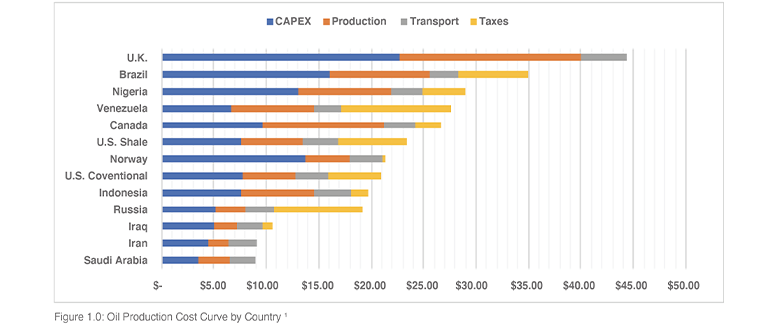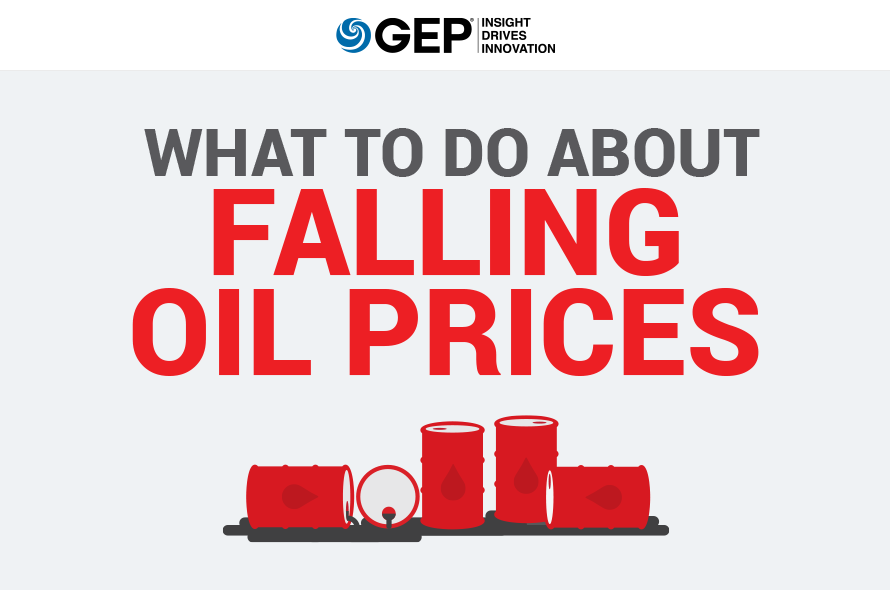To help sustain a downturn, you want to trim your material and operational costs out of your P&L today.
Now is the time to step up and help weather the storm. Head-count reduction, consolidation, bankruptcy and production cuts aren’t the full answer.
The latest GEP BULLETIN “What to Do About Falling Oil Prices” directly addresses how to manage procurement and your supply chain in the current unstable economic climate.
Learn all about how to:
- Use targeted, realistic sourcing of key spend categories
- Make the right investments in user-first, intelligent supply chain technology
With 20 years of procurement and supply chain experience, GEP is uniquely positioned to help build targeted downturn strategies quickly with our proprietary market intelligence built specifically for oil and gas categories such as, tubulars, beams, cementing, liner hanger, mud plant, coating, and well intervention services.
The headlines look grim.
“Oil Crashes by Most Since 1991”
“Oil Price Plunges as Much as 30% After OPEC Failure Sparks Price War”
Indeed, the times ahead will prove challenging under the dual strain of demand declines due to the coronavirus outbreak and a rush to glut the market by Russia and Saudi Arabia.
Despite the tough economic news, it is the perfect time for procurement and supply chain teams to step up and help their companies weather the storm.
Clearly, Saudi Arabia has the wherewithal to outlast just about any U.S. shale producer, or any other producer for that matter, thanks to highly advantageous geology. Saudi formations are 5x more porous than their U.S. shale counterparts, and its permeability is a staggering 25x better. The U.S. and Russia, the two main victims of the Saudi approach cannot compete on a cost basis and will have to blink first.

Figure 1.0: Oil Production Cost Curve by Country 1
However, unlike the last time Saudi Arabia aggressively stopped defending the oil price in 1985, procurement and supply chain organizations are much more mature and sophisticated – providing an additional arrow in a producer and services company’s quiver that did not exist in the 1990s.
Perhaps most importantly, the kind of value that procurement and supply chain leaders can provide tends to bear fruit faster and be more sustainable to the enterprise in the long-run than head-count reduction, consolidation, bankruptcy or production cuts.
WHAT PROCUREMENT AND SUPPLY CHAIN LEADERS CAN DO TO HELP
Here at GEP, we think the time is ripe for two key plays in the oil and gas sector:
1. Employ targeted, realistic sourcing of key spend categories, especially those categories that can underpin ongoing operations even if new drilling stalls to make sure the value actually accrues to the P&L, and …
2. Make investments in modular supply chain technology that can easily link spend to contracted pricing without cumbersome ERP system usage, to unlock one-time cash infusions and prevent inefficiencies from sinking profitability further.
WE SAY ‘TARGETED, REALISTIC SOURCING’ FOR A REASON: IT ACTUALLY PROVIDES VALUE.
During the last downturn in 2014-2015, a significant portion of oil and gas procurement departments invested in strategic or semi-strategic sourcing activities to “reduce cost.” But only a fraction of those companies could realistically trace the “savings” accrued to the P&L.
In fact, much of the activity simply beat suppliers up for a quick discount without any thought of codifying and following that value. For example, over 90% reported cost reduction in contract as their key metric to the enterprise, but only 10% tracked spend on contract as a key metric. As a result, many companies failed to see real uplift in earnings per share from that activity.
Instead, we suggest a tiered approach to the market that seeks larger reductions from suppliers that have broad portfolios (MRO, Chemicals, some Production Services) and more win-wins from early discounts, collaborative cost reduction and open book pricing for more constrained, specialist providers (OFS, OCTG, Rigs).
MAKE THE RIGHT INVESTMENTS IN USER-FIRST, INTELLIGENT TECHNOLOGY.
To respond in this rapidly eroding market, focus investment on solutions that provide quick and tangible value. For example, getting spend on POs has been a constant challenge for upstream players. But companies that invest in digital field ticket technology can better drive spend to PO channels, which will drive an increase in their spend on contract by 15-20%.
Likewise, companies can make significant strides by investing in material and inventory visibility. Investing in a telematics-driven system to track bulk deliveries of sand and water can instantly reduce transactional volume by 10-15 % as “ghost” or fraudulent deliveries are eliminated. And it can further reduce detention charges by up to 25%.
HOW GEP CAN HELP YOU UNLOCK VALUE DURING THE DOWNTURN
Similarly, a key area of potential value during a downturn is the reuse of non- or slow-moving inventory. During the last downturn in 2014-2015, inventory as a % of spend increased 3x, indicating a clear value opportunity to draw down on key inventories as drilling and completions activities decrease. But capturing that opportunity requires two key factors:
- Real time visibility to materials and their condition
- The ability to transact against that visibility seamlessly without multiple system interaction points.
A key example is a system that can track and transact materials already allocated to drilling and completions projects — and return them to general stock if they are not consumed with one click.
HOW GEP CAN HELP YOU UNLOCK VALUE DURING THE DOWNTURN
As a market leader in procurement and supply chain strategy, services and software for 20 years, GEP is uniquely positioned to deliver value quickly, effectively and sustainably. We help organizations build targeted downturn strategies by leveraging our proprietary market intelligence built specifically for the oil and gas sector for categories such as: tubulars, beams, cementing, liner hanger, mud plant, coating, and well-intervention services.
Further, we can rapidly deploy our tried and tested modular supply chain solutions that give immediate visibility to material and inventory – and enable the ability to intelligently do something with it.
In a recent case, we were able to deploy a warehouse-inventory solution to multiple sites in less than four months. In many cases, we will make significant co-investment with our clients because we understand the value of partnerships and eschew the transactional relationship model.
If you would like to have a conversation about how we can help, please reach out to our Oil and Gas leadership.
Let’s talk.

Santosh Nair
Vice President, GEP
Santosh has over 12 years of experience managing large-scale procurement transformation engagements for leading Fortune 500 companies. At GEP, he’s responsible for developing new products and services by incorporating complex aspects of mobile interfaces, social media, cloud computing and big data to ensure client needs are met.

